Alexandre Lacassagne, the French forensic pathologist who published a book on tattoos in 1881, would have been astonished at, and puzzled by, the explosion of elaborate and professional tattoos in the general population in the last three decades.
Icame to the “Restoring a Nation Conference” with the journalist’s equivalent of a Michelin Guide, Integralism, A Manual of Political Philosophy (2020) by Thomas Crean, O.P. and Alan Fimister. If I were to go to a conference spearheaded by Catholic intellectuals—Sohrab Ahmari, Gladden Pappin, Adrian Vermeule, Patrick Deneen, among others—and hosted by a preeminent bulwark of intellectual Catholicism—the University of Steubenville—I at least needed to make an effort to fit in. Although a practicing Catholic myself and a fairly close follower of the debates within the ‘New Right,’ I had the same anxiety concerning integralism as I did the Church Catechism—that they were both thick books of ideas that I should know by heart, but if asked to recount them I might sound like that kid who is cold-called and thought he could rely on someone else to do the homework and speak up first.
Early in the book, I was struck by the authors’ rich poetic description of the “Common Good”—a subject recently debated to great depth in the New Criterion:
Closely related to the activity of a society is the notion of the common good. This notion is more restricted than that of a ‘shared good.’ A common good is a good which can be shared entirely [emphasis in original] by several persons. Thus when several persons share a cake, the cake is not a common good, for no one person can have the whole of it. But when several persons enjoy some work of art or philosophy together, this work is a common good; the enjoyment which one person receives from the work does not lessen that of the others, and may even increase it [emphasis mine]. … Material things, by contrast, are always diminished by being shared.
In addition to art and philosophy, the authors point to the “spiritual good” as a fruit and reflection of the common good, attesting that:
Only on the basis of such a good [the common good] can one reciprocally will the good of another for the other’s own sake.
Throughout the conference, painstaking efforts were made by the speakers to distinguish between the common good—an ultimately spiritual good for the whole society, which cannot be commodified—and materialism. The common good, the speakers explained, was not ultimately a material achievement—an achievement of the right amount of ‘stuff’ as consumer capitalism and right- and leftwing liberals believe—but a spiritual one. Yes, as Catholic social teaching emphasizes, a base level of material needs should, indeed must be met, but the ends of that material comfort go beyond the material. More happy and fruitful marriages—sacramental marriages, as Professor Scott Hahn insisted, not merely civil ones; more beautiful public spaces, as Patrick Deneen advocated; and more faith in God’s providence and purpose for us all—none of these are finite resources to be doled out in a zero-sum-game relational economy of scarcity. Anyone who has a happy and fruitful marriage rejoices at others who do; anyone who can walk in a revitalized town square and take pride in it takes pride all the more so in seeing others congregate there; and anyone who loves God with all their heart rejoices at another parishioner in the pews. The common good is a spiritual version of the Keynesian multiplier. Marriages, families, meaningful, fulfilling and well-paying work are not meant to be the luxury goods of an elite—but that is what they have become.
I was struck, then, stepping onto the University of Steubenville campus, by a subtle but undeniable sense of the common good that reminded me of when I rediscovered my Catholic Christian faith in college. The students on campus seemed cheerful, polite, and happy to be on campus; they seemed to glow with God’s grace. Many—perhaps most—of the conference attendees stood side-by-side with them at a packed Friday afternoon Mass in the campus chapel. I saw little of the tattoos, piercings, and immodest dress that are de rigueur in my native Los Angeles. After Mass, a man in his 70s struck up a conversation with me in the hotel lobby, telling me how much he loved his alma mater, and I got the sense, to paraphrase the title of Ahmari’s great recent book, that the campus too was an “unbroken thread”—a spiritual and temporal vessel for willing the good of the other as the other.
In the opening roundtable called “The Post-Liberal Promise: Another World is Possible” Patrick Deneen, Gladden Pappin, and Sohrab Ahmari laid out the case that postliberalism is not merely a forward-looking, prescriptive term, but a descriptive one that to a large extent is merely playing catchup with reality. “The global liberal political order is indeed over,” Pappin surmised. “The global internet is over. China and Russia now have their own internet. Global manufacturing and global supply chains are over,” Pappin added, in reference to the shortages and bottlenecks produced by the pandemic. “Only 20% of Western Europeans say they’ll even die for their country,” he added. “Liberal societies won’t even defend themselves.”
As a speaker, Pappin had a clear gift for deadpan irony and sarcasm, and the audience erupted into laughter on more than one occasion. The professor alluded to Thomas Friedman’s ludicrous “Golden Arches of Peace Theory.” A twist on the Kantian “democratic theory of peace,” the so-called McDonald’s theory was that countries with McDonald’s never started wars with each other. By that logic, he argued, “We shouldn’t be pulling McDonald’s out of Russia, we should be building more of them!” Why aren’t we “carpeting bombing Russia with McDonald’s

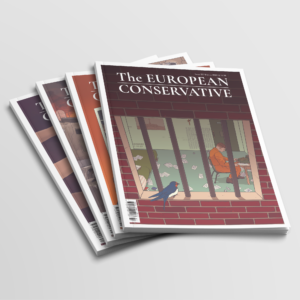




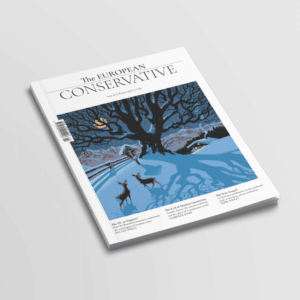
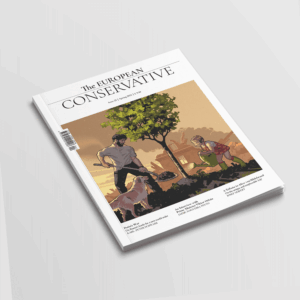


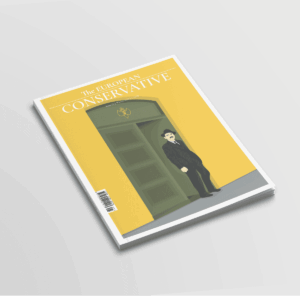
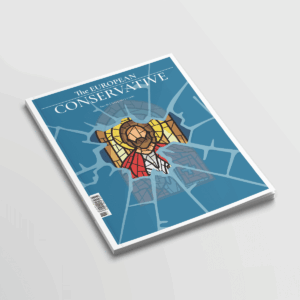
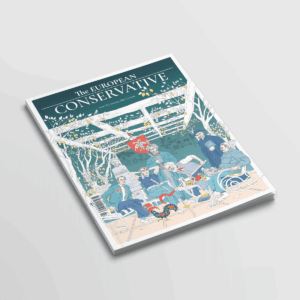
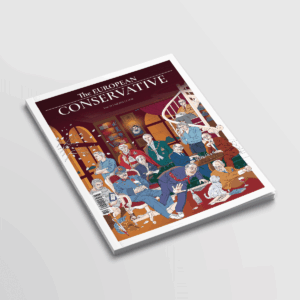
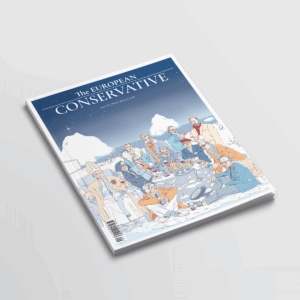

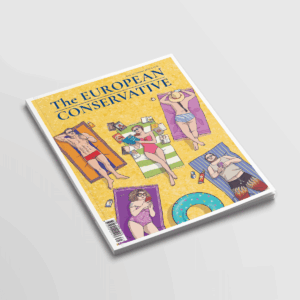

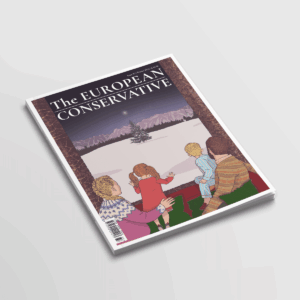




Probably in full awareness of the cosmopolitan bias of big media and elite academia, as well as that of prestigious academic conferences, towards ‘flyover country,’ Patrick Deneen gave a moving account of the Rust Belt decline in his native Indiana and Ohio. The conference’s aspirations to shaping national—even international—political debate on the Right, then, were mirrored by a distinct respect for the local. (This sentiment would be reinforced a day later by the appearance of J.D. Vance, the Trump-endorsed nationalist-populist candidate for Senate who also tries to thread the needle, on the campaign trail, between the universalism of his convert-acquired Catholic faith and the sometimes erudite intellectual tradition it represents, and the particular concerns of Ohioans.)
Deneen projected onto a screen above him pictures of urban blight in Steubenville, Ohio and South Bend, Indiana, and juxtaposed them to bombed-out and beautifully rebuilt cities of similar size in his wife’s native Germany. “It looks like we lost a war, not Germany,” he proclaimed. “American people pay lots of money,” he added, “to walk through these beautiful European cities.” Meanwhile, our own cities wither and decay. This wasn’t the result of the “invisible hand,” Deneen reminded us, in allusion to the free-market fundamentalism of Conservatism Inc.; “it was intentional … [This was] the intentional strip-mining of our country.”
“There is another way,” Deneen said repeatedly to the point where my despair at the present melted into a cautious optimism about the future. In my memory, at least, the volume of his voice almost dropped when he said this, closer to a whisper than a shout—as if he could feel the birthing pains of a new world in his bones. This too was a constant undercurrent of the conference—oscillations between equally eloquent articulations of despair at the present and an intrinsically Christian hope for the future.
Constitutional scholar Adrian Vermuele’s afternoon keynote on the first day, “The Constitution of Imperium,” was an esoteric exercise linking the growth of power in the American executive with precedents in Roman imperial law (Lex Regia). Without drawing explicit analogies to the present, he defended the relative benevolence of select Roman imperial rulers against the “inability of a corrupt senatorial class to govern for the common good.” One could see such a statement as a means to justify the use of executive orders, for instance, as actions made in the name of the common good against a corrupt and decadent American Congress concerned only with its narrow self-interest.
In the same speech he added what old guard Republicans would have considered heretical praise for big government: “There is no alternative to the administrative state,” he declared, “there is no dismantling of it.” Perhaps these statements are true, but as one attendee pointed out to me in an aside, “the administrative state is controlled by Democrats.” If the deep state is here to stay—a term I embrace but which Vermeule did not use—then we are still a long way from theory to practice—from how to purge and replace the left-wing obstructionists in its ranks in the event of another Republican presidency. I was assured by this same attendee that efforts were already underway, at American Moment and elsewhere, to train a new generation of right-wing bureaucrats to implement the nascent nationalist-populist agenda of the New Right should the opportunity arise.
Vermeule’s assertions of the ultimate indestructibility of big government—and what is more, the undesirability and imprudence of wishing its demise—was reiterated elsewhere. A prime example was his defense, along with Ahmari and Patrick J. Smith, of FDR’s New Deal policies. All three argued for links between the Catholic social teaching of Pope Leo XIII, Pope Pius XI and others and the New Deal. They went as far to suggest that New Deal legislation undergirded and decisively contributed to the economic prosperity of the postwar Golden Era of high-paying and unionized manufacturing jobs. Ahmari extolled so-called “socially managed capitalism” and introduced a phrase unfamiliar to me: “political-exchange capitalism.”
Ahmari, in his speech on “private tyranny” took as a given that so-called market forces can be—and often are—coercive, and that the only way to fight woke capital’s reign of worker terror is with the tools of the state and within the framework of Catholic social teaching. Political Catholicism, Ahmari suggested, needed to reclaim ownership—but this time, for the Right—of the pro-worker, pro-union agenda that previously made rustbelt Catholics staunch Democrats. Ahmari argued—and did so cogently—that in the 1980s figures like Michael Novak were in the ascendancy. Novak’s work and others codified into ‘fusionist’ law (big tent conservatism) the intellectually incoherent notion that conservative Catholics must be free-market neoliberals while all pro-labor Catholics were “seamless garment” lefties ensnared by the beguiles of liberation theology. It was now time, Ahmari claimed, to move past that false dichotomy.
If Ahmari’s, Deneen’s, Vermuele’s and Patrick J. Smith’s postliberalism harkens in some ways to more recent memory—to the elderly or to those, like myself, who have heard stories from now-deceased grandparents about the Great Depression—then there was also a postliberalism of older provenance on display. The postliberalism that harkens back to the medieval era and even earlier might better be called integralism, as it often presents itself more in the language of an arcane instruction booklet—the integralist manual of Crean and Fimister mentioned above being a prime example. Chad Pecknold gave a glimpse of what this older postliberalism might look like rhetorically in the retail political market when he asserted—against the inevitable charges to come of theocratic fanaticism—that America needs “a public orientation towards God.” He listed off cities in America—from Saint Augustine to San Francisco—with Saint names, reminding us that America’s cultural patrimony is not just Protestant, but Catholic as well.
In what may have been one of the most memorable lines of his speech, if not the conference as a whole, he compared America’s rightly ordered “civic altars” of old to the woke left’s “foul altars” erected today in the name of a specious humanism. Leftists, he explained, were a kind of heretical Christian sect, and we should see them as such. In his words, they are “darkly gnostic” and “destroyers of the good”: “Even in their rebellion [against God] they call for solidarity and common worship.”
He referenced the now ubiquitous gay pride flag that adorns buildings across the country during pride month. “They have planted the flag of a new faith on a foul altar,” he proclaimed. “Foul altar,” I remembered thinking to myself, is the exact kind of integralist diction that can and should also serve as an inherently populist diction.
Pecknold continued: “Theodosius crushed foul altars,” an allusion to Roman times that was lost on me, a poor soul who, I say only half-sarcastically, did not receive an education steeped in the Western tradition as you might at one of the Great Books Programs at Catholic University of America, the University of Dallas, or Wyoming Catholic College. Professor Deneen tweeted during the conference that he was glad there was finally an event without a reference to the founders; but references to the ancients were apparently still encouraged. I, along with the American public, have a long way to go as far as our education in integralism is concerned.
The punchiest and most YouTube-ready speeches came, in my opinion, from Rachel Bovard and Josh Hammer, co-hosts of the Edmund Burke Foundation’s weekly current affairs show, “NatCon Squad.” I attribute this to their professional backgrounds as political commentators and policy analysts as opposed to being academics by trade. Co-hosts of the Edmund Burke Foundation’s “NatCon Squad” weekly current affairs show, their speeches were concise, their language clipped and nearly free of academic jargon. Hammer expressed ambivalence towards the term “New Right” which he said he both loved and hated. The New Right, he explained, is “more nationalist, more communitarian,” and that it was becoming—with much more room to grow—the party of average Americans, not “the laptop class,” and not “the hedge fund class.” The New Right, he suggested, is also more religious: “Only religion [can effectively fight] … woke pseudo-religion.”
Hammer went as far as to argue for an outright ban on gender-reassignment surgery, “even for those over eighteen,” and reveled in Ron DeSantis’s “victory over Mickey Mouse the groomer”—a reference to Disney’s sparring with the Florida governor over issues of ‘gay rights.’ Hammer, like previous speakers, framed the New Right’s distinguishing trait as the willingness to embrace government as a tool to achieve conservative goals:
This is a time to build, not slash. To wield power, not abhor power.
The latter comment referred to a running theme in Gladden Pappin’s scholarship, going back at least to a 2017 article in American Affairs, which he co-founded, wherein he decried the lack of a conservatve theory of how to execute state power to conservative ends, as opposed to the “starve the beast” obsession of libertarians.
Bovard, a beltway veteran herself, opened her speech with cutting humor. “Forty years is a long time,” she explained, alluding to the start of the Reagan Presidency, “and the more things change, the more things stay the same in the Republican establishment.”
The New Right, she said, echoing sentiments expressed by Mathew Continetti in his new book The Fight for the Right, isn’t entirely new. “Coolidge and Taft would be perfectly comfortable,” she explained, with many of the New Right’s stances on trade (protectionist) and foreign affairs (“isolationist” to detractors or simply “realist” to supporters).”
“We all know what’s coming next,” she presaged, “throuples’ rights, normalized pederasty, post-birth abortion,” contending—like Hammer before her and like others earlier in the conference—that state power would sometimes need to be called upon in service of the culture wars. “The family and nation must be defended,” she explained, “at times against the government, and at times with the government.”
A last-minute addition to the roster of speakers after the printing of the conference brochure was Mary Imparato of Belmont Abbey College. Ironically—or not—her talk came on the heels of Bovard and Hammer’s as part of the same panel. This was ironic because not only are Bovard and Hammer co-hosts of “NatCon Squad,” but because they both were featured speakers at the National Conservatism conference in Miami a few weeks before the Steubenville conference. Imparato—and here the irony—had recently made a splash in postliberal circles by penning a piece as a guest author for the “Postliberal Order” Substack. In her post, titled “What I Saw at Nat Con,” she claimed that the National Conservatism movement was at odds with integralist–that is, Catholic-postliberalism. In the piece, she insinuated that establishment conservatives (“neocons”) may have ingratiated themselves into the National Conservatism movement and further lamented the absence of any Catholic integralist cadre at the NatCon event. “the most coherent Catholic postliberal political thinkers weren’t even there, and their absence tells the whole story,” she wrote.
Subsequently, in a brief exchange of words on Twitter, one of the NatCon movement’s founders, Yoram Hazony, reminded Gladden Pappin that he had in fact spoken at a previous NatCon in Brussels. Hazony tweeted it seemed that there had been “a unilateral boycott of NatCon [Miami] by some of the leading ‘Catholic integralists.’” (According to the NatCon website, Patrick Deneen and Sohrab Ahmari were featured speakers at previous NatCons, as well.)
Perhaps it should come as no surprise, then, that in her speech, Imparato directed criticism yet again at the NatCons—the only explicit criticism I heard of the National Conservative movement at the conference. (The European Conservative published the National Conservatism Statement of Principles earlier this year.)
Imparato’s talk was moving in its depiction of her faith. She argued that she was an “integralist before I even knew what the word meant” when she gazed upon the statue of freedom atop the dome of the U.S. Capitol. and told a friend, “Wouldn’t it be beautiful if one day that were a statue of the Holy Mother instead?” No, the friend responded, because in America religion and state were necessarily separate. Imparato argued that Catholics need not be apologetic about their religion, and (presumably) need not hide their desire to bring America—and the world, if possible—into the fold of their faith. Were these words in themselves controversial? Perhaps. Were these the kinds of thoughts many Catholics did—and do—think but dare not say in public? Absolutely. Can an overtly proselytizing faith win over American voters? On that point she did not elaborate.
But then Imparato went a step further. She accused Yoram Hazony of an anti-Catholic bias in two ways. She pointed to a video of a NatCon speech by a Catholic speaker, from which Imparato claimed references to the Virgin Mary were deliberately removed, as an example of anti-Catholic animus. This accusation was later definitively debunked by the NatCon speaker herself:
To explain the circumstances that have led to some confusion & some different editions of this speech … There is a moment when, reflecting on the image of Christ crucified, I briefly lose my composure. [NatCon organizers], in a spirit of charity and discretion, advised … the editors to paper over the pause. This was done graciously to protect me from embarrassment, but I am not embarrassed. These are grave topics, and that they move us to tears is a grace! To eliminate confusion and controversy, [we] decided to restore it to its fullness.
Imparato’s main accusation of anti-Catholic bias, however, referred to Hazony’s scholarship. She cited a paragraph from his book, The Virtue of Nationalism, which she contended equated Catholicism with Nazism. Did she mean that Hazony harbored a personal bias against Catholicism, or that his scholarship was unsound? Or did she believe that Holy Roman Empire was only a religious and not a political project? On this point, I believe she was unclear.
Indeed, Hazony’s argument that the West’s distinctive character–above all the nation-state–emerged in opposition to the universalist ambitions of the Holy Roman Emperor to dominate Mitteleuropa is not new. Henry Kissinger made a similar argument several times over—most recently in his book World Order; although, one could indeed argue that the civic nationalism of the (non-Protestant) Renaissance Italian city-states, or even the emergence of Catholic France under Cardinal Richelieu in opposition to the Catholic Holy Roman Empire, might poke holes in the argument that nationalism and Protestantism are indissolubly, exclusively linked.
Regardless, I was left wondering: Can’t one critique the geopolitical aspirations of certain Catholics—such as the Holy Roman Emperor—without slandering Catholicism itself? Is it not simply the truth that the nation-states and nationalism writ-large was in fact given a big assist by Protestant dissenters from Henry VIII of England to Gustavus Adolphus of Sweden or Martin Luther of Germany? And, as lamentable as the Protestant-Catholic divide remains to this day, should we not be grateful for the plurality of competitive nation-states—some Protestant and some Catholic—which emerged in the early modern European world?
I immediately thought of Josh Hammer’s words: “It’s a time to build, not to slash.”
Bringing in J.D. Vance to close out the conference with a barn-burner of a speech was a stroke of genius. His personal political transformation from a libertarian-inflected establishment conservative to a national-populist, along with his deep ties to the white working class and his conversion to Catholicism, epitomize all that is hopeful about the postliberal political movement.
Vance repeatedly lamented the role of money in politics, and he told moving stories about his interactions with voters—particularly about their ability to scramble the right-left political categories in the way they think. But to me his greatest contribution to the conference was the one that seemed most tailored to us, the Catholic (and non) political geeks in the audience. He directly alluded specifically to some of the (perceived) tensions between NatCons and Postliberals by mentioning the danger that a reprisal of libertarian-traditionalist conservatism might hijack the ‘postliberal’ conservative movement.
“Yes,” he said, “there is a risk of ‘fusionism 2.0’” usurping the movement; that is, that the establishment would take over and neuter the movement—from “riding the tiger” to borrow Pedro Gonzalez’s brilliant analogy, to taming the tiger.
But, Vance admonished us,
We can’t be mean to each other. … The way to prevent a ‘fusionism 2.0’ is to persuade each other, not beat each other up.
Vance too, then, was speaking to the language of the common good adumbrated by Thomas Crean and Alan Fimister. In the postliberal Right of the future, its various strains will build upon and strengthen one another, just as the fruits of the common good—family and children, nation and parish—are ultimately self-multiplying spiritual goods of God’s grace. That is, just as the truly common good cannot be commodified—it cannot be subtracted from and coveted, only added upon—the truly Christian postliberal order can only grow, not diminish.